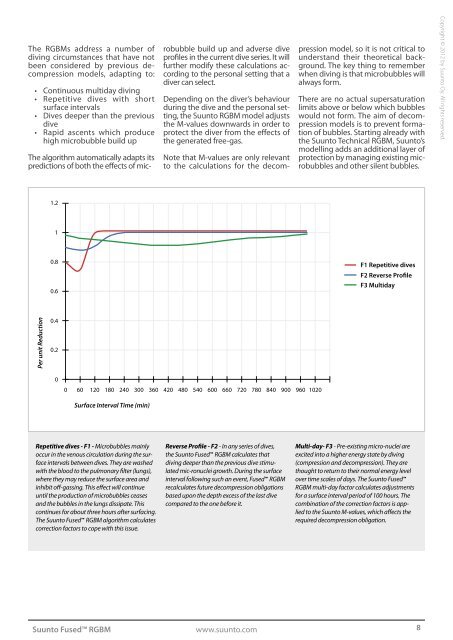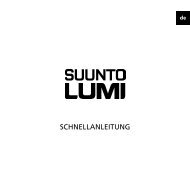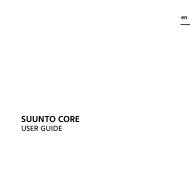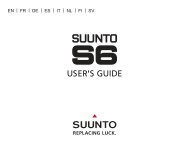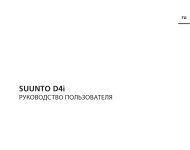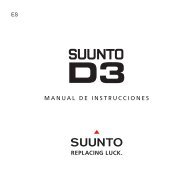Suunto Fused™ RGBM
Suunto Fused™ RGBM
Suunto Fused™ RGBM
- No tags were found...
Create successful ePaper yourself
Turn your PDF publications into a flip-book with our unique Google optimized e-Paper software.
The <strong>RGBM</strong>s address a number ofdiving circumstances that have notbeen considered by previous decompressionmodels, adapting to:• Continuous multiday diving• Repetitive dives with shortsurface intervals• Dives deeper than the previousdive• Rapid ascents which producehigh microbubble build upThe algorithm automatically adapts itspredictions of both the effects of microbubblebuild up and adverse diveprofiles in the current dive series. It willfurther modify these calculations accordingto the personal setting that adiver can select.Depending on the diver’s behaviourduring the dive and the personal setting,the <strong>Suunto</strong> <strong>RGBM</strong> model adjuststhe M-values downwards in order toprotect the diver from the effects ofthe generated free-gas.Note that M-values are only relevantto the calculations for the decompressionmodel, so it is not critical tounderstand their theoretical background.The key thing to rememberwhen diving is that microbubbles willalways form.There are no actual supersaturationlimits above or below which bubbleswould not form. The aim of decompressionmodels is to prevent formationof bubbles. Starting already withthe <strong>Suunto</strong> Technical <strong>RGBM</strong>, <strong>Suunto</strong>’smodelling adds an additional layer ofprotection by managing existing microbubblesand other silent bubbles.Copyright © 2012 by <strong>Suunto</strong> Oy. All rights reserved.1.210.8F1 Repetitive divesF2 Reverse Profile0.6F3 MultidayPer unit Reduction0.40.20060 120 180 240 300 360 420 480 540 600 660 720 780 840 900 960 1020Surface Interval Time (min)Repetitive dives - F1 - Microbubbles mainlyoccur in the venous circulation during the surfaceintervals between dives. They are washedwith the blood to the pulmonary filter (lungs),where they may reduce the surface area andinhibit off-gassing. This effect will continueuntil the production of microbubbles ceasesand the bubbles in the lungs dissipate. Thiscontinues for about three hours after surfacing.The <strong>Suunto</strong> Fused <strong>RGBM</strong> algorithm calculatescorrection factors to cope with this issue.Reverse Profile - F2 - In any series of dives,the <strong>Suunto</strong> Fused <strong>RGBM</strong> calculates thatdiving deeper than the previous dive stimulatedmic-ronuclei growth. During the surfaceinterval following such an event, Fused <strong>RGBM</strong>recalculates future decompression obligationsbased upon the depth excess of the last divecompared to the one before it.Multi-day- F3 - Pre-existing micro-nuclei areexcited into a higher energy state by diving(compression and decompression). They arethought to return to their normal energy levelover time scales of days. The <strong>Suunto</strong> Fused<strong>RGBM</strong> multi-day factor calculates adjustmentsfor a surface interval period of 100 hours. Thecombination of the correction factors is appliedto the <strong>Suunto</strong> M-values, which affects therequired decompression obligation.<strong>Suunto</strong> Fused <strong>RGBM</strong> www.suunto.com 8


